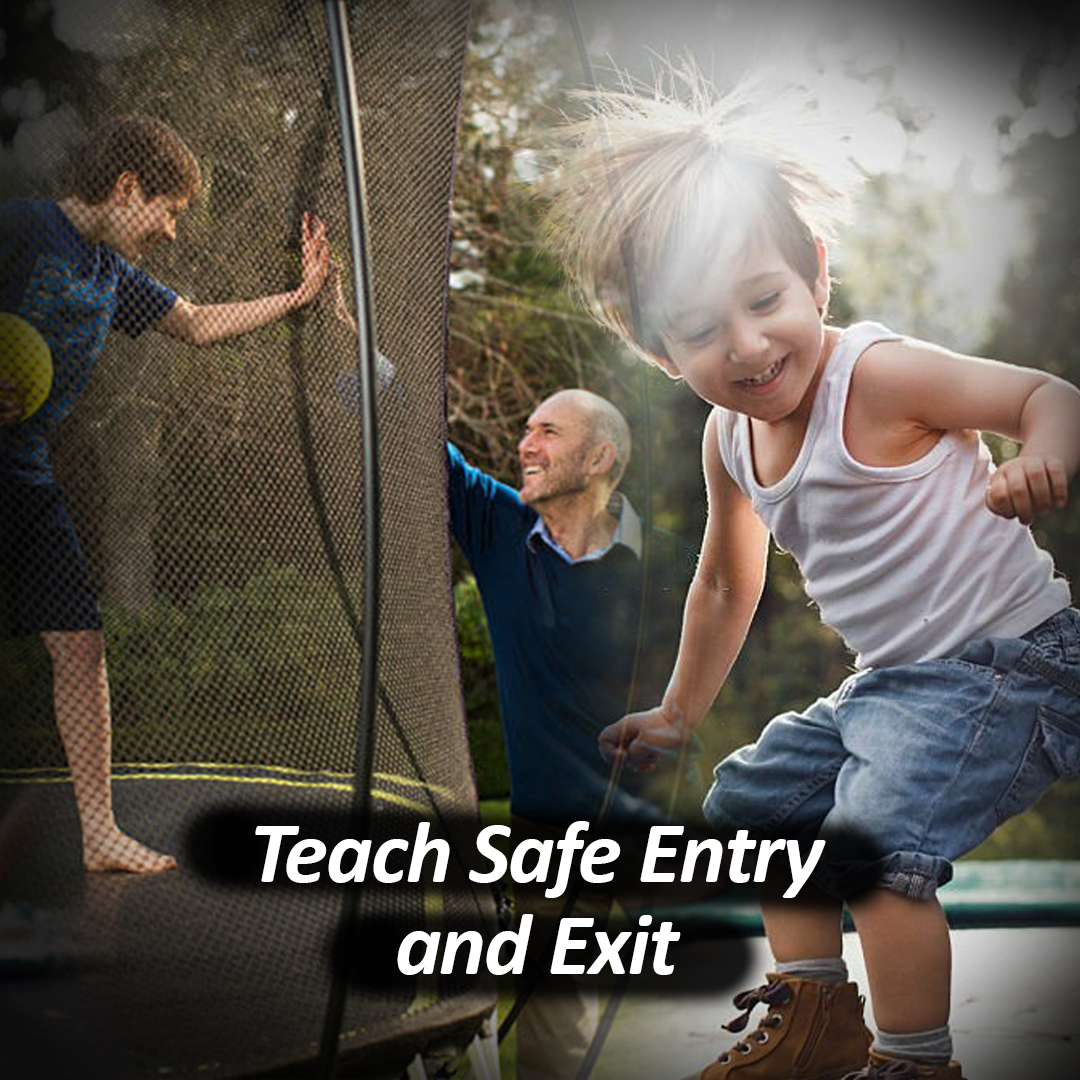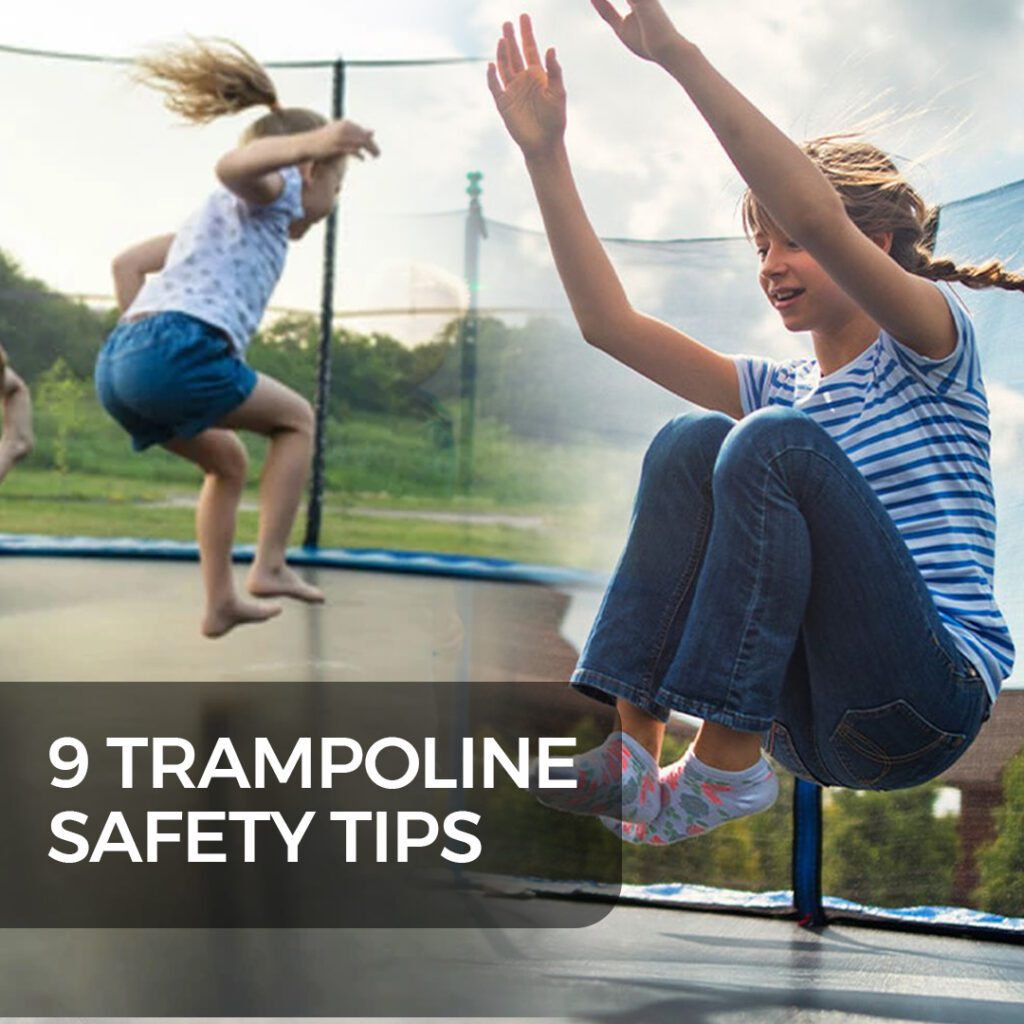
We understand that trampolines can be loads of fun, especially for children, but it’s crucial to discuss how to keep everyone safe while enjoying the excitement. It’s easy to follow safety tips and ensure your children can have a great time bouncing on the trampoline without any concerns.
From preventing falls and collisions to dealing with various weather conditions, we’ve got you covered.
So, let’s delve in and discover how to preserve the joy of trampolining while ensuring everyone stays safe and happy!
Potential Risks of Trampolines
Trampolines can be great fun for children, but they also come with risks that you should be aware of before letting your little ones jump.
Falls and collisions
Trampolines that are placed over hard, unprotected surfaces like concrete can lead to injuries from falls. Always place protective padding over the springs, frame and surrounding area. Consider installing safety netting around the trampoline to prevent children falling off, and make sure only one child is jumping at a time.
Broken bones and sprains
The repetitive impacts from jumping can cause fractures, especially in small, developing bones. Ankles, wrists and elbows are particularly at risk. Properly supervise children and teach them basic safety like no somersaults or flips.
Head and neck injuries
Landing incorrectly after jumps or collisions can cause head, face and neck trauma. Enforce rules like no double bouncing, make sure children land on the middle of the trampoline, and consider helmets for younger children.
While scary, the good news is most trampoline injuries can be prevented by following some basic safety tips. Lay down ground rules before the first jump, properly supervise children at all times, ensure safety gear like padding and netting is installed and well-maintained, and lead by example by jumping safely yourself. With the proper precautions taken, you and your children can have hours of fun and bounce your way to health and happiness. But as with any physical activity, there is always an element of risk, so know the dangers and take trampoline safety seriously.
Teach Safe Entry and Exit
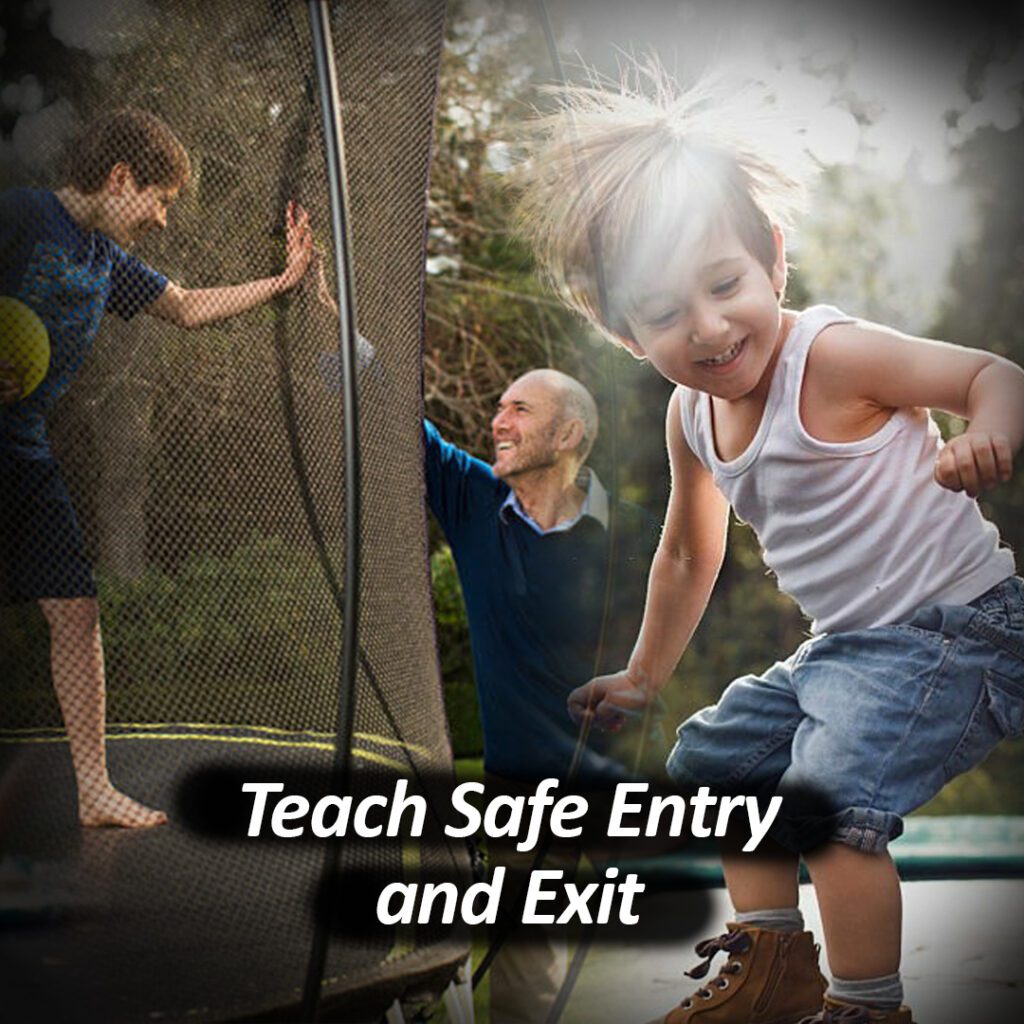
Ensuring that children enter and exit the trampoline safely is a critical aspect of trampoline usage. To promote safe practices, it’s essential to encourage children to approach these actions with care. First and foremost, emphasise the importance of entering and exiting one at a time. This minimises the risk of collisions and falls, fostering a controlled environment for trampolining.
Additionally, provide a sturdy ladder or step stool for access to the trampoline. This not only facilitates a secure entry but also discourages any attempts to climb onto the trampoline without proper assistance. Waiting for the trampoline to come to a complete stop before entering or exiting is key to avoiding unnecessary risks.
Moreover, instruct children to refrain from jumping off the trampoline onto the ground. Instead, advocate for a safer approach—stopping the bouncing, walking to the edge, and carefully stepping down. This practice significantly reduces the likelihood of sprains, twists, or more severe injuries that may occur when jumping from an elevated surface.
In summary:
Enter and exit one at a time: Minimise the risk of collisions by encouraging a controlled approach.
Provide a sturdy ladder or step stool: Facilitate secure access and discourage climbing without proper assistance.
Wait for the trampoline to stop: Emphasise the importance of patience for a safe entry and exit.
Avoid jumping off the trampoline: Stop bouncing, walk to the edge, and carefully step down to prevent injuries.
By instilling these safe entry and exit practices, children can enjoy the trampoline experience while significantly reducing the risk of accidents and injuries. Parents should actively reinforce and supervise these behaviours to establish a culture of safety during trampolining activities.
Weather Awareness
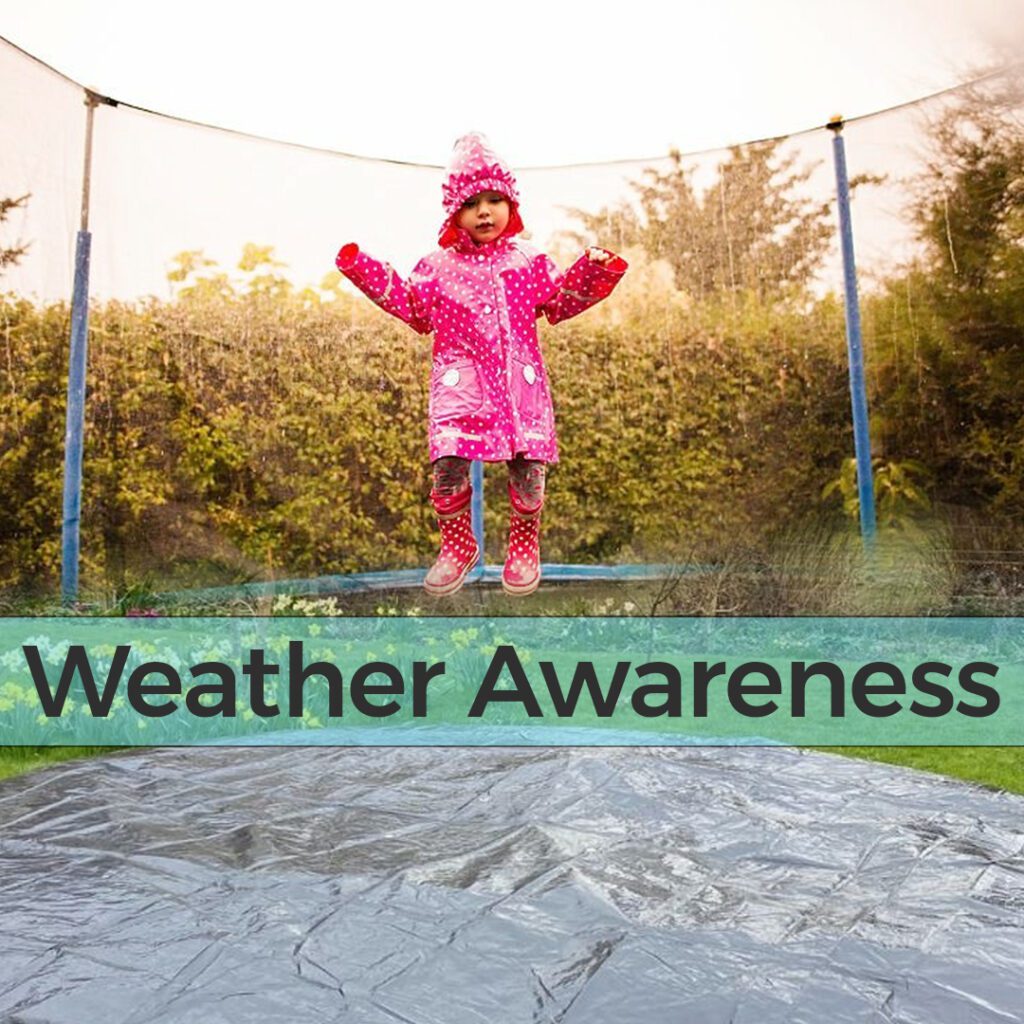
When it comes to trampoline safety, being mindful of the weather is paramount. Firstly, it’s important to avoid trampolining during adverse weather conditions such as rain, snow, or thunderstorms. Wet surfaces can become slippery, heightening the risk of accidents, and the presence of lightning poses a severe danger. In such conditions, it’s advisable to keep everyone indoors.
Moreover, during periods of strong winds or storms, it’s essential to take proactive measures to secure the trampoline. This can be achieved by using anchors or tie-downs to firmly secure the trampoline to the ground. Additionally, consider investing in a trampoline cover or, in extreme weather, dismantling the trampoline to prevent damage. It’s equally important to store any loose accessories or components in a safe place during adverse weather.
Furthermore, educating children about the significance of staying off the trampoline in inclement weather is crucial. Instil the habit of checking the weather conditions before engaging in trampolining activities. Teach them that safety always takes precedence, and waiting for suitable weather conditions is a responsible practice. Emphasise the unpredictable nature of weather and the potential risks involved, reinforcing the importance of making safety-conscious decisions.
By adhering to these weather-related safety measures, parents can ensure a secure trampolining environment for their children, minimising the risk of accidents associated with adverse weather conditions.
In summary:
Avoid trampolining during adverse weather: Rain, snow, and thunderstorms can create hazardous conditions.
Secure the trampoline during storms: Use anchors or tie-downs and consider using a trampoline cover or dismantling it in extreme weather.
Store loose accessories safely: Keep any detachable parts stored securely during adverse weather conditions.
Educate children on weather awareness: Instil the habit of checking weather conditions before trampolining, emphasising safety first.
9 Trampoline Safety Tips for children
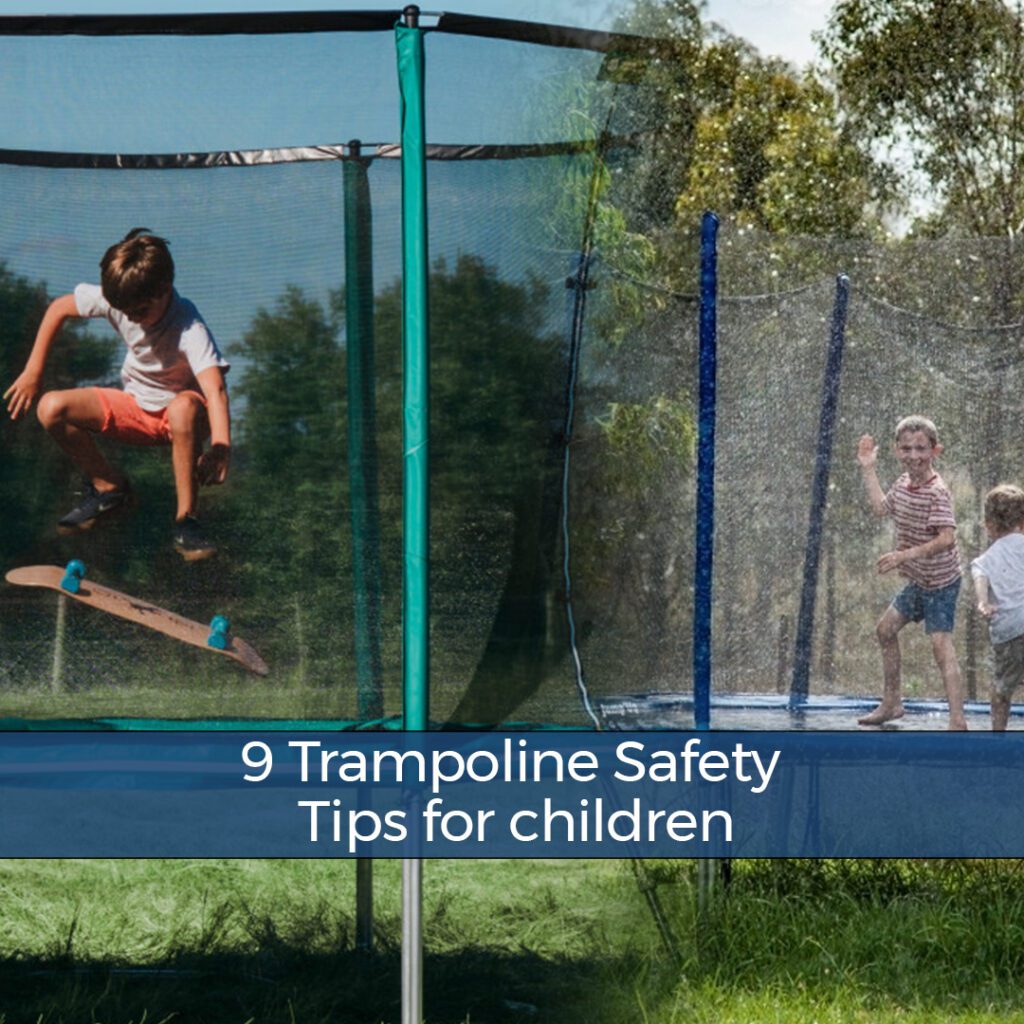
To keep your children safe on the trampoline, follow these key tips:
#1 Proper Supervision
Never leave children unsupervised on the trampoline. An adult should always be present to watch for unsafe behaviour and spot jumpers. Only one child should jump at a time if an adult isn’t actively spotting.
#2 Age Limits
Trampolines can be dangerous for young children. Children under 6 years old should not use a trampoline for safety purposes. Always follow the manufacturer’s recommended age limits.
#3 Safety Padding
Safety padding covers the springs and frame, preventing injuries from collisions. Make sure all padding is securely attached before each use. Replace any worn or damaged padding immediately.
#4 One at a Time
To prevent collisions, ensure that only a single child jumps on the trampoline at a time. No more than two or three children should be on a residential trampoline at once, with only one actively jumping while the other spots.
#5 No Flips or somersaults
Flips, somersaults, and aerial stunts are dangerous and should not be attempted. Only basic bounces and jumps are allowed.
#6 Secure the Netting
Safety netting prevents falls from the trampoline but will not prevent injuries if it is not properly secured. Ensure the netting is tightly secured to the mat and poles and covers the whole jumping surface before each use.
#7 Bounce in the Centre
Jumpers should stay in the centre of the mat, away from the springs and frame. Bouncing too close to the edge can cause injuries from collisions.
#8 No shoes
Shoes should be removed before jumping to prevent injuries. Only bare feet or grippy socks should be worn on the trampoline.
#9 One Bounce at a Time
Only one bounce or jump should be performed at a time. Chaining multiple flips or twists together increases the chance of losing control and getting injured.
• Take breaks to prevent exhaustion and collisions
• Check for damage before each use and replace parts as needed
• Follow the manufacturer’s weight limit to prevent damage and injuries
• Discuss rules and safety before allowing children to jump
• Consider safety gear like helmets, wrist guards, and knee pads, especially for younger children
By following these essential tips, you can ensure your children have fun and stay safe on the trampoline this summer. Their safety is worth taking the proper precautions.
Conclusion
As we bring our exploration of trampoline safety to a close, it’s evident that crafting a secure environment for your children’s enjoyment requires a blend of awareness and action. Trampolines offer endless fun, yet the risks associated with falls, collisions, and varying weather conditions cannot be ignored.
Trampoline safety starts with a secure enclosure, regular inspections for wear and tear, and strict adherence to weight limits. Always supervise children and follow guidelines for proper usage.
To prevent injuries, ensure one person bounces at a time, perform controlled jumps, and avoid attempting advanced tricks without proper training and supervision. Follow safety guidelines diligently.
Regularly inspect your trampoline for damaged parts, including the frame, mat, and springs. Ensure the enclosure is intact, and follow the manufacturer’s maintenance recommendations to keep it in top condition.
No, a net is a must for trampoline safety. There is no alternative; it provides essential protection. Follow weight limits, supervision guidelines, and always use a net to ensure the safest bouncing experience.
Land with your knees slightly bent, ensuring an even distribution of impact. Avoid landing on your head or neck. Always jump and land in the center to reduce the risk of injury.

